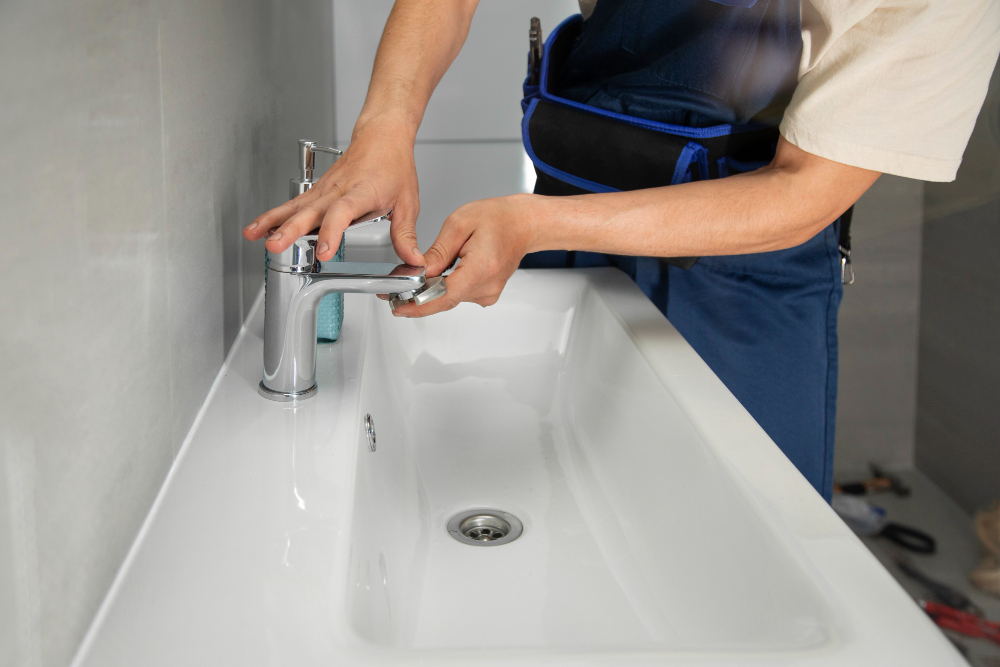Single-hole sink faucets need proper care, including regular cleaning with mild soap and warm water to prevent dirt and mineral buildup[1].
Timely repairs for leaks and worn-out parts like washers and cartridges are essential to maintain the functionality and appearance of these single-hole faucets for years to come.
Moreover, installing a faucet aerator can help conserve water and reduce splashing, contributing to a more efficient and eco-friendly bathroom setup.
Ensuring proper installation by a professional plumber can prevent potential issues and ensure optimal performance.
Table of Contents
ToggleWhat is the Most Frequent Failure in a Typical Faucet?
The most common failure in a typical faucet is a leak, often caused by worn-out washers, O-rings, or cartridges.
These components can degrade over time due to regular use, leading to water seepage and dripping.
Regular maintenance and timely replacement of these parts can help prevent leaks and ensure the faucet’s proper functioning.
Common Faucet Issues and How to Fix Them
If you’ve got any of these faucet problems, it’s best to act immediately to prevent the situation from worsening.
Dripping Faucet
A dripping faucet is a widespread issue caused by worn-out internal components such as washers, O-rings, or valve seats.
To fix it, identify the faulty part and replace it with a new one. Regular maintenance can prevent dripping.
Low Water Pressure
Low water pressure can result from clogged aerators, mineral buildup, or issues with the water supply.
Cleaning or replacing the aerator, checking for pipe blockages, or adjusting the shut-off valves can resolve this problem.
Leaky Faucet
Leaks can occur due to damaged seals, loose connections, or worn-out components.
Tighten loose connections, replace damaged seals or cartridges, and ensure proper installation to fix leaks.
Regular inspections and maintenance can prevent leaks.
Faucet Handle Issues
Worn-out or improperly installed components often cause loose or squeaky faucet handles.
Tighten loose screws, lubricate moving parts, or replace worn-out handles to resolve handle-related issues.
Uneven Water Flow
Uneven water flow may indicate clogged aerators, mineral deposits, or issues with the water supply.
Clean or replace the aerator, check for blockages in pipes, and ensure proper water pressure to restore even water flow.
Temperature Control Problems
Issues with temperature control can stem from faulty cartridges, worn-out seals, or problems with the water heater.
Replace faulty cartridges, and worn-out seals, or adjust the water heater settings to achieve proper temperature control.
Persistent Noises
Strange noises like squeaking, whistling, or banging may indicate loose parts, water pressure issues, or mineral buildup.
Tighten loose connections, adjust water pressure, or clean components to eliminate persistent noises.
Continuous Running Water
A faucet that continuously runs can waste water and increase utility bills.
Check for worn-out washers, damaged seals, or issues with the shut-off valve.
Replace faulty components or adjust the shut-off valve to stop continuous running water.
Corrosion and Rust
Corrosion and rust can develop on faucet components over time, affecting performance and aesthetics.
Clean affected areas with a suitable cleaner, replace corroded parts and consider installing a water softener to prevent future corrosion.
Faucet Installation Problems
Improper installation can lead to various faucet issues such as leaks, loose handles, or uneven water flow.
Follow manufacturer instructions carefully, use proper tools, and ensure tight connections to avoid installation problems.
If you need help, seek professional help for installation.
Tips for Cleaning and Caring for Your Single-Hole Faucets
- Clean your single-hole faucet regularly with mild soap and warm water to prevent buildup.
- Avoid abrasive cleaners to prevent scratching the finish.
- Soak a cloth in white vinegar and wrap it around affected areas to dissolve mineral deposits. Scrub gently with a soft brush or sponge to remove residue.
- Remove the aerator and soak it in vinegar to dissolve deposits. Use a brush to scrub and remove debris, then rinse thoroughly.
- Use a soft cloth or microfiber towel to polish the finish regularly.
- Avoid abrasive materials and use a mild metal polish for the specific finish type.
- Install a water softener to prevent mineral buildup from hard water.
- Wipe down the faucet after each use and dry thoroughly to prevent water spots.
- Check for leaks and address them promptly to prevent water damage.
- Inspect components like washers and cartridges, replacing any worn-out parts.
Key Takeaway
Regular maintenance, prompt repairs, and proper installation are essential for preventing and resolving common faucet issues.
By identifying the underlying causes and implementing appropriate solutions, homeowners can ensure their faucets function optimally and last longer.


